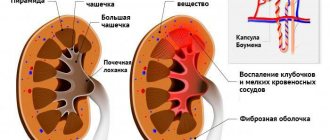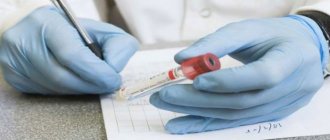Ketone bodies
(syn.
acetone bodies
) - a group of organic compounds that are intermediate products of the metabolism of fats, carbohydrates and proteins. The appearance of increased amounts of ketone bodies in the blood and urine is an important diagnostic sign indicating a violation of carbohydrate and fat metabolism.
Ketone bodies include beta-hydroxybutyric acid (see Hydroxybutyric acids), acetoacetic acid (see) and acetone (see); they have a similar structure and are capable of mutual transformations:
What is acetone in the blood
Most often, acetone appears in the blood due to a violation of fat metabolism, as well as the absorption of carbohydrates.
A synonym for acetone in the blood is acetonemia.
This condition is accompanied by the accumulation of a significant amount of ketone bodies in the human body. They first appear in the blood, and then in urine. However, diagnosis of pathology is carried out through urine analysis. This test is the most effective way to detect acetonemia.
Acetonuria can be detected at home using special test strips
Today, the level of acetone can be easily determined at home. To do this, test strips are used, which are lowered into a container with urine. They acquire a pink tint if traces of acetone are observed in the urine; in the case of pronounced acetonuria, the stripes turn purple.
Everything you need to know about ketones
In order to understand why it is necessary to monitor the level of ketones in urine and/or blood and under what circumstances this is really important, let's understand what ketones are and why they appear in human blood and urine.
The word ketone comes from the old German word Aketon (acetone). Ketones or ketone bodies are substances consisting of a combination of oxygen with hydrogen and a hydrocarbon.
There are many types of ketones, for example, ubiquinone, it is extremely important for the functioning of the heart; the ketone group contains fructose, progesterone, cortisone, tetracycline, camphor, natural dyes and many other substances.
Ketones are constantly synthesized in liver cells and are present in the urine and blood of every person; they are excreted daily in small quantities, of which
70% comes from weak beta-hydroxybutyric acid,
26% for the stronger acetoacetic acid (acetoacetate) and
4% for acetone.
Acetone, in addition, is also released during breathing, so such a small amount of it in urine cannot be determined using samples. It is believed that the norm for ketones in the urine of a healthy person is their complete absence.
To provide tissues and organs with energy, the body uses glucose or glycogen, which is stored in small quantities in the liver, as its source. When the intracellular glucose level is reduced and the cells “experience hunger,” the body’s fat reserves begin to mobilize.
Fat is broken down in the liver and during this process, byproducts are formed - ketone bodies. They can be used as an alternative source of energy by the kidneys, heart, muscles and brain.
A condition in which an excess of ketones is detected in the blood is called ketonemia, and in the urine - ketonuria. Most often, ketones are tested in urine, and there are a number of diseases and conditions that lead to ketonuria. These include: poor nutrition (starvation), excessive physical and emotional stress, frostbite, intoxication, severe infectious diseases and injuries, pancreatitis, thyrotoxicosis, alcoholism and diabetes.
What unites such different conditions, we can already answer - ketones are produced when cells are “starved” or when there is a deficiency of insulin, therefore, a distinction is made between “hungry ketones” and ketones in diabetes mellitus, although chemically these substances are no different.
During fasting, food does not enter the body, blood glucose levels decrease, insulin production stops and its antagonist, the hormone glucagon, enters the blood; it forces the body to use glycogen reserves located in the liver. When these reserves run out, adipose tissue begins to break down and ketones are formed.
In diabetes mellitus, the blood glucose level, on the contrary, is increased, but there is not enough insulin and glucose from the blood cannot enter the cell, the cell experiences “hunger”, but the body perceives this situation in the same way as during fasting. The hormones adrenaline and glucagon are produced, glycogen is broken down in the liver, then adipose tissue and ketones are formed. This situation is also called “hunger amid plenty.” Glucose circulates in excess in the bloodstream without entering the cells, the resulting ketones also enter the blood, and then both substances are excreted in the urine and only the administration of insulin can break this vicious circle.
Insulin deficiency can be caused by various reasons:
- The debut of type 1 diabetes mellitus, when a person does not pay due attention to the symptoms of the disease;
- Various conditions in patients with type 1 diabetes mellitus in which the need for insulin increases. For example, puberty, a period of active growth, an acute infectious disease accompanied by fever, surgery, injury;
- Missing insulin injections within 12-24 hours for any reason;
- Depletion of own insulin production in patients with type 2 diabetes mellitus;
- Concomitant diseases, surgeries, injuries in patients with type 2 diabetes mellitus;
- Taking various medications (cortisone, diuretics, estrogens, gestagens) by patients with both types of diabetes mellitus;
- Removal of the pancreas in persons who have not previously suffered from diabetes.
Related material:
Hormones that regulate blood glucose levels
Insulin and its importance for the body
About ketones. Briefly and in pictures
Ketoacidosis
The accumulation of ketones in the blood is called ketosis and, if the insulin deficiency is not corrected, ketones change the pH of the blood to the acidic side, have a toxic effect on the body and ketoacidosis .
The body tries to fight excess ketones by excreting them in the urine, urination becomes more frequent, and acetone is also excreted through the lungs, giving the exhaled air a specific “fruity” smell. Nausea, vomiting, abdominal pain, and general weakness also gradually increase; all this can lead to the development of a life-threatening condition - ketoacidotic coma. Treatment of ketoacidosis must be carried out in a hospital by administering the required volume of fluid and insulin.
It is extremely important to remember the following situations in which it is necessary to determine the level of ketones in the urine:
- You get sick, for example, with a cold accompanied by fever;
- Blood glucose level is more than 14-15 mmol/l for several hours;
- You have symptoms of insulin deficiency (nausea, vomiting, abdominal pain, rapid breathing, smell of “acetone” on your breath).
Related material:
Diabetic ketoacidosis. Video
Complications of diabetes
How can you determine the level of ketones in your urine?
Ketones in urine can be determined in the laboratory and at home. To do this, a special strip soaked in an alkaline substance and sodium nitroprusside is placed in the urine for 1 minute (available in pharmacies). If there are elevated levels of ketones in the urine, the strip changes color from white to brownish-red. The reaction is assessed using a color scale - “negative”, “small”, “medium” and “significant” ketone content. The test is easy to perform and can be performed an unlimited number of times.
For more accurate and specific results, you need to take a blood , which can also be done in the laboratory and at home. In addition, test strips react with urine acetoacetate and cannot detect beta-hydroxybutyric acid in urine, making them unsuitable for assessing the effectiveness of treatment for diabetic ketoacidosis.
The results are interpreted as follows: normal blood ketone levels should be below 0.6 mmol/L, a level of 0.6-1.5 mmol/L indicates the possibility of diabetic ketoacidosis, and > 1.5 mmol/L indicates a high risk ketoacidosis or existing ketoacidosis.
Comparison and Concordance of Blood and Urine Ketone Levels
| Blood ketone level (mmol/l) | Urine ketone levels |
| 0 – 0,5 | "negative" or "traces" |
| 0,6 – 1,0 | "traces" or "small" |
| 1,1 – 1,5 | "small" or "significant" |
| 1,5 – 3,0 | "significant" |
It is important to know about possible false-positive and false-negative results for determining ketonuria.
False-positive result (ketones are detected in the urine, but there is no risk of developing diabetic ketoacidosis) due to:
- Taking certain medications (for example: captopril, valproate);
- Acetone can circulate in the blood for many hours, even after the required dose of insulin has been administered. In this case, new ketones are not formed and are not detected in the blood.
False negative result (ketones in urine are not detected, but they are there) due to:
- Taking plenty of vitamin C (ascorbic acid) or salicylic acid (found in many painkillers such as aspirin);
- The lid of the can of stripes has been open for too long;
- The test strips have expired.
Thus, if ketones are detected in the morning urine and the blood glucose level is low, these are “starved ketones . You may experience general weakness and nausea; if such symptoms appear, you need to eat carbohydrate-containing food, followed by the introduction of the required dose of insulin. Also be sure to check your blood glucose levels the following night to rule out the possibility of nocturnal hypoglycemia. A high level of glucose in the urine indicates that blood glucose levels were high during the night, although they are low in the morning hours.
If the level of ketones in the urine (and/or blood) is high and the blood glucose level exceeds 15-20 mmol/L, this indicates insulin deficiency . The number one priority is to administer an additional dose of insulin. That's why:
- Enter 0.1 U/kg body weight of short-acting insulin (preferably Novorapid or Humalog);
- Determine your blood glucose level after 1-2 hours;
- Give another 0.1 U/kg body weight if blood glucose levels have not decreased;
- Do not administer short-acting insulin more frequently than every 3 hours to avoid delayed hypoglycemia;
- Determine the level of ketones in the blood an hour after administering an additional dose of insulin - it should decrease;
- Consume more fluids (water);
- If your blood ketone level is 3 mmol/L or more, consult a doctor immediately!
Ketones during pregnancy
A common cause of concern is the detection of ketones in urine in pregnant women. About 30% of pregnant women who do not have diabetes have ketones in their morning urine.
Ketones in urine during pregnancy can be observed if a woman follows a carbohydrate-free diet for a long time, in case of poisoning, infectious diseases, severe emotional stress, or gestosis. Ketones in urine can also signal diabetes.
Pregnancy is a period during which there is a risk of developing so-called specific diabetes of pregnant women or gestational diabetes mellitus. The disease usually disappears on its own after childbirth, but during pregnancy it can significantly affect the development of the baby. Therefore, when ketones are detected in the urine during pregnancy, first of all, it is important to exclude diabetes mellitus, including type 1 diabetes mellitus, the onset of which may coincide with the onset of pregnancy.
During different periods of pregnancy, women with type 1 diabetes have different insulin needs. It is reduced at the beginning of pregnancy, and then rises steadily, until almost 36-38 weeks, when it becomes twice as high as before pregnancy. This is due to weight gain during pregnancy and the secretion of hormones produced by the placenta that counteract the decrease in blood glucose levels.
During pregnancy, ketone production increases during periods of insulin deficiency, making the development of ketoacidosis more likely.
Ketoacidosis during pregnancy is very dangerous for both mother and baby.
It is necessary to regularly monitor the level of ketones in the blood or urine, especially if you feel unwell or have an illness accompanied by a fever. Eating “slow carbohydrates” before bed reduces the risk of hypoglycemia at night and the appearance of “hungry ketones.”
Thus, the level of ketones is undoubtedly an important indicator, the control of which does not require much effort (determining the level of ketones in urine or blood takes no more than 5 minutes), but answers many questions related to the disease. Timely control prevents the development of a life-threatening condition – diabetic ketoacidosis.
Related material:
Gestational diabetes mellitus
Diabetes and pregnancy
6 myths about diabetes and pregnancy
Acetone content rate
Ketone bodies are normally absent in the blood.
More precisely, their blood contains no more than 1–2 mg per 100 ml. This indicator is so insignificant that it cannot be diagnosed using standard laboratory tests.
Ketone bodies are chemical compounds formed in the human liver from foods that come from outside. Their formation occurs thanks to proteins and fats. Ketone bodies are necessary in small quantities for humans because they are a source of energy. If their level exceeds the norm, this threatens intoxication of the body.
Benefits of ketosis for the human body
In addition to being an excellent alternative source of energy for the body, ketones have a number of other benefits. In particular, BHA (beta-hydroxybutyric acid) reduces inflammation and oxidative stress, which play a significant role in the development of many chronic diseases.
The following positive effects of mild ketosis have been proven:
- Weight loss. When a person manages to properly enter ketosis, he automatically begins to eat less, by reducing the amount of carbohydrates and consuming as much fat and protein as needed to satiate. Since the keto diet reduces appetite, lowers insulin levels in the blood and stimulates the breakdown of fat tissue, it is not surprising that it is more effective than most weight loss diets.
- Control of diabetes and prediabetic conditions. In people with type 2 diabetes or prediabetes, ketosis helps normalize blood sugar levels and reduce the so-called insulin response. As a result, you can increase the intervals between taking medications.
- Possible improvement in muscle tone. Ketosis provides a greater supply of energy for muscle function. This can help both athletes achieve impressive results and ordinary people leading an active lifestyle.
- Prevention of convulsive conditions. Maintaining mild ketosis using the classic keto diet (also a less strict version of the Atkins diet) has been proven to be effective for epilepsy. The frequency of seizures is reduced in both children and adults, even if anticonvulsant drug therapy does not produce the expected effect.
Research is regularly conducted and the possible effectiveness of the ketogenic diet for certain diseases is considered: migraines, polycystic ovary syndrome, and brain cancer. Possibly slowing the progression of Alzheimer's disease. Thus, the keto diet and achieving proper ketosis can help patients live a long and healthy life and increase the period of remission for chronic incurable diseases.
Symptoms of the presence of acetone
There are a number of symptoms and signs that may indicate the development of an acetone crisis:
- Refusal of food and water due to nausea and lack of appetite.
- Every meal is accompanied by vomiting, which can also be permanent.
- The presence of signs of dehydration: the level of urine output is reduced, the skin is pale and dry, weakness is felt, etc.
- Signs of a malfunction of the central nervous system (CNS) - the initial excitement is quickly replaced by a lethargic state and drowsiness. There is a possibility of seizures.
- An elevated temperature is observed.
- The smell of acetone appears from the mouth, urine has a similar smell, as well as vomit.
- The liver increases in size.
- A biochemical blood test shows that the level of chlorides and glucose is reduced, cholesterol and lipoproteins, on the contrary, are observed in increased quantities. The general analysis demonstrates an increased content of leukocytes and ESR.
Assessment of the degree of acetone syndrome in children - table
| Clinical symptoms | Clinical interpretation | |||
| 0 | 1 | 2 | 3 | |
| Symptoms of intoxication | none | minor | moderate | expressed |
| Vomit | none | from 2 to 5 times | from 5 to 10 times | 10 or more times |
| Abdominal pain | none | weak | moderate | strong |
| Appetite | saved | reduced | sharply reduced | none |
| Thirst | drinks normally | drinks greedily | drinks sluggishly | doesn't drink |
| Degree of acetonuria | missing (-) | minor (+, ++) | moderate (+++) | expressed (++++) |
Bilirubin and glucose: normal
Bilirubin is a certain pigment, has a yellow-green tint, and is formed as a result of the breakdown of hemoglobin in the blood. Bilirubin is found in the blood serum of any person, as well as in his bile. The pigment in the blood is divided into several types:
- Direct bilirubin is neutralized and completely prepared by the liver for further removal from the body.
- Indirect bilirubin is toxic, newly formed and not yet bound in the liver.
New Information: Blood Sugar Limits for Diabetes
Such data can be shown by a blood test carried out in a laboratory by adding a special reagent to a person’s blood.
To determine the level of pigment, it is necessary to take a biochemical blood test. To obtain reliable data, the following rules must be followed:
- The test is performed exclusively on an empty stomach.
- Blood is taken from a vein.
The normal level of total pigment (that is, direct plus indirect bilirubin) ranges from 8 to 20 µmol/l. The norm for indirect pigment is no more than 17 µmol/l, and for direct pigment up to 4.4 µmol/l. In situations where the analysis shows indirect bilirubin 15-17 µmol/l, it is recommended to donate blood again.
High rates may indicate various pathologies in the body, so the doctor prescribes numerous examinations to determine the exact causes of this condition, and only then recommends treatment.
Blood sugar in men and women does not depend on their gender, body weight, etc., but differs solely by age. Ideally, blood glucose should not exceed 5.5 mmol/l. In older age, in particular from 50 years or more, the acceptable norm is from 5.9 to 6.9 mmol/l. For general information, we recommend an article on our website in which blood sugar levels by age are discussed in the form of tables.
In conclusion, it is worth saying that if a deviation from the norm is detected in the tests, the doctor must establish the exact causes of this condition and promptly prescribe the required therapy.
Reasons for the increase
Acetone levels may increase for the following reasons:
- improper diet, in which the body does not receive the necessary nutrients and vitamins. This is often observed when a person is fasting, eats mainly foods with a high fat content, when introducing a significant amount of protein into food and cutting carbohydrates, and also if the body is subjected to excessive physical stress;
- progression of diabetes mellitus;
- surgical intervention, which was accompanied by the use of general anesthesia;
- poisoning of the body with toxins;
- increased body temperature;
- excessive drinking;
- the presence of toxicosis during pregnancy, which is accompanied by constant vomiting;
- progression of pathological conditions: the presence of malignant tumors in the gastrointestinal tract;
- various infectious diseases;
- liver pathologies;
Diabetes mellitus - video
How to properly enter ketosis?
There are ways to quickly and correctly enter a state of ketosis:
- Reduce the proportion of carbohydrates in your diet to 20 g per day. In principle, there is no urgent need to adhere to such strict restrictions. But in theory, consuming less than 20 grams of carbohydrates (in terms of net carbs) per day will ensure that you reach a state of ketosis.
- Try intermittent fasting. Taking 16 to 18 hours between meals will also help you enter a state of ketosis. To do this, you skip breakfast or lunch. By the way, following the nutritional rules of the keto diet, which reduces the feeling of hunger, intermittent fasting will not be accompanied by any discomfort.
- Don't be afraid to eat fatty foods. Eating fatty foods is not only a must, but also a very enjoyable part of the ketogenic diet! Be sure to include a significant portion of fat in every meal on the keto diet.
- Cook with coconut oil. Coconut oil is a natural vegetable fat that does not break down when heated. It contains medium-chain fatty acids, which serve as the “raw material” for the production of ketone bodies and support brain function.
- Move whenever possible. At first, you may not have the energy or desire for serious physical activity (sports, heavy work, etc.). However, even regular walks at an easy pace will help you reach a state of ketosis faster. After this, the body will switch to an alternative source of energy, and even serious physical activity will no longer be a problem.
What are the consequences of deviation from the norm?
If the problem of increased acetone is detected in a child or pregnant woman, emergency hospitalization is required, since doctors consider this condition dangerous. As a result of increased accumulation of ketone bodies in the human body, the following complications and consequences may occur:
- dehydration/intoxication;
- premature birth, miscarriage;
- coma and even death.
Note! Ketonemia is a condition that occurs when acetone enters the bloodstream. Ketonuria occurs when the level of ketones in the blood reaches its critical point.
Ketonuria in children
The reason for the detection of acetone in the urine of children is most often overwork, stress, emotional overload, or a long trip. Acidosis also occurs against the background of viral, infectious diseases, intestinal infections, especially if the disease is accompanied by high fever or frequent vomiting.
In addition, ketones in the urine in children under 12 years of age indicate insufficient fluid intake in the body, as well as an incorrect and unbalanced diet.
A temporary and slight increase in the level of ketone bodies in children is easily corrected and most often does not cause serious pathologies.
However, ketonuria in children may also indicate serious disorders in the body, such as a brain tumor, liver failure, diabetes mellitus, and dysfunction of the thyroid gland. Therefore, it is important, when a KET indicator is detected in a child’s urine test, to conduct repeated studies to prevent the development of pathologies.
Normalization methods
Acetone, which appears in diabetes, can be removed by saturating the human body with the correct glucose. To do this, just eat something sweet.
It is possible to remove acetone from the body by drinking a significant amount of liquid. However, it is difficult to do this on your own due to the repeated vomiting that accompanies the condition.
Sweetened tea, fruit juice or compote will help rid the body of acetone without causing vomiting. This drink should be given a teaspoon every few minutes.
Fruit juice will help rid the body of acetone without causing vomiting
It is also possible to get rid of acetone with the help of a proper diet, which will be based on the consumption of light carbohydrates: semolina or oatmeal, mashed potatoes, vegetable broth, etc.
Diet requirements:
- Meat can only be dietary: rabbit, turkey, veal. It is recommended to stew, boil, bake;
- fish should be lean (for example, hake, pollock);
- vegetables and fruits will help restore water balance. Quince is useful for acetonuria; compote or jam is made from it. The consumption of citrus fruits and bananas is not recommended.
Products that help normalize the condition - gallery
Fruits
Vegetables
Pollock cooked in the oven
Rabbit meat
Boiled turkey
To remove ketone particles in diabetes, cleansing enemas are given. In especially severe cases, acetone can only be eliminated during hospitalization.
It is possible to prescribe medications that prevent dehydration. For this purpose, a solution called Regidron or its analogues, which can normalize water-salt metabolism, is suitable. Additionally, a glucose solution with a concentration of 5% can be used. Enterosorbents are also shown, including Smecta, Enterosgel, Filtrum, etc.
Diagnostics
Diagnosis of ketone bodies in urine is an important medical study that allows one to identify the level of acetone intoxication in the body. Ketonuria in an advanced state can cause serious harm to a person, therefore, when acetone is detected in the urine, it is important to establish the exact cause of this pathology.
The final interpretation of a general urine test in the presence of ketone bodies should only be carried out by a doctor. Methods for diagnosing the presence of acetone in the body include not only a urine test, but also a blood test, thanks to which it will be possible to determine a more accurate level of ketone bodies in the blood.
Based on additional laboratory tests, the doctor will be able to determine whether diabetes mellitus is the reason why ketones were detected in the urine, or whether this pathology arose against the background of another disease.
The cut-off value, which serves as an indication for further monitoring of the patient's condition, is determined at the level of 0.5 mmol/l in blood tests. A reading above 1-2 mmol/l will indicate long-term intoxication with ketones.
To confirm the diagnosis of diabetes mellitus, in addition to a general study of the level of ketone bodies in the urine and blood, a blood test for glucose is performed. If the determination of glucose levels does not show an excess of the norm, you will need to look for another cause of the pathology.
Prevention of high acetone content
To prevent the appearance of acetone, an adult must adhere to these simple rules:
- systematically engage in sports;
- give up all bad habits;
- maintain a proper diet;
- undergo regular medical examination.
To prevent the appearance of acetone in a child, it is enough to monitor the products he consumes:
- give up chips, sweet carbonated drinks, fatty foods, smoked meats and processed foods;
- Replace sweets from the store with natural fruits and homemade desserts.
Therapeutic diet for ketonuria
When treating the disease, the main emphasis is on adjusting the person’s diet. His daily menu should include the following dishes:
- vegetables;
- meat without fat (rabbit, turkey, beef);
- vegetable soups;
- porridge;
- nuts (walnuts or hazelnuts);
- green tea;
- low-fat fermented milk products;
- berry fruit drinks;
- lean fish;
- fruits other than citrus fruits.
A diet for acetonuria requires excluding the following dishes from the diet:
- offal;
- high fat dairy products;
- alcohol;
- fast food;
- any fried, canned or smoked food;
- coffee;
- mushrooms;
- fat meat;
- sweet;
- any types of citrus fruits;
- tomatoes.
Additionally, to remove acetone from the body, the patient must drink frequently. Water is consumed 4 times within an hour in small volumes. Drinking alkaline water without carbon, chamomile infusions and dried fruit compotes is beneficial. If necessary, the patient is given enemas consisting of a 2% solution of soda and water.
In severe forms of acetonuria, patients are given droppers based on the drugs “Regidron”, “Cerucal”. The latter is indicated in the presence of vomiting. It is recommended to cleanse the body by taking adsorbents, which include activated carbon and the drug “Sorbex”. For inflammation, Ketonal is additionally prescribed.
Increased energy and focus
Very often, people are plagued by brain fog, a feeling of fatigue, and “flu-like” sensations of body aches when they first start any low-carb diet. This scares them and they “jump off”, returning to their usual diet. But there is no need to be afraid. This is a natural adaptation of the body and everything will pass in 10-14 days. This is the so-called “keto flu”. When it passes, the body reaches a new level. Attentiveness increases, the energy level is almost always stable, there is practically no state: “ I’m falling off my feet, and I’ll fall asleep where I sit down .” When you reach ketosis, the brain starts using ketones instead of glucose. It is a cleaner source of energy for him as it is 60% fat.
The effects of ketones on the brain to help people with brain diseases, concussions, memory loss have been tested in medical settings:
- ketone bodies for the treatment of Alzheimer's disease; ()
- therapeutic effects of ketone bodies in brain injuries; ()
- the effect of beta-hydroxybutyrate on people with impaired memory. ()
NB: If you have gone through the keto flu, your concentration has improved, your energy levels are consistently high, then you are most likely in ketosis.
Weight loss
Many people resort to low-carb diets, including the keto diet, to lose weight. In the first week, the weight comes off very quickly. This drains water along with glycogen stores. Well, some of the fat goes away. Then the weight will decrease gradually, provided there is a calorie deficit. The upside is that the calorie deficit may not be as severe as with regular diets. The main thing is to teach the liver to produce BHB (beta-hydroxybutyrate) and, when there is no food, to use subcutaneous fat reserves for energy supply. Therefore, on a keto diet it is important to achieve 2 meals a day.
NB: Rapid weight loss occurs when you first start the keto diet (I lost 6 kg in the first 16 days!). Then this process slows down.
Short-term fatigue
Switching to a ketogenic diet can come with a number of side effects. These include weakness and fatigue. Because of this, people often leave the keto diet without getting everything that full-fledged ketosis could give them. It usually takes 7-30 days to achieve full ketosis, sometimes longer, depending on your age and body characteristics. To reduce fatigue, take extra electrolytes, which are lost due to the rapid drainage of water held by carbohydrates in the body. Use 2000-4000 mg sodium per day, 1000 mg potassium and 300 mg magnesium .
NB: You may initially suffer from fatigue and loss of energy, but this will pass as you adapt to the ketones. At this time, you should not engage in exhausting sports activities.











